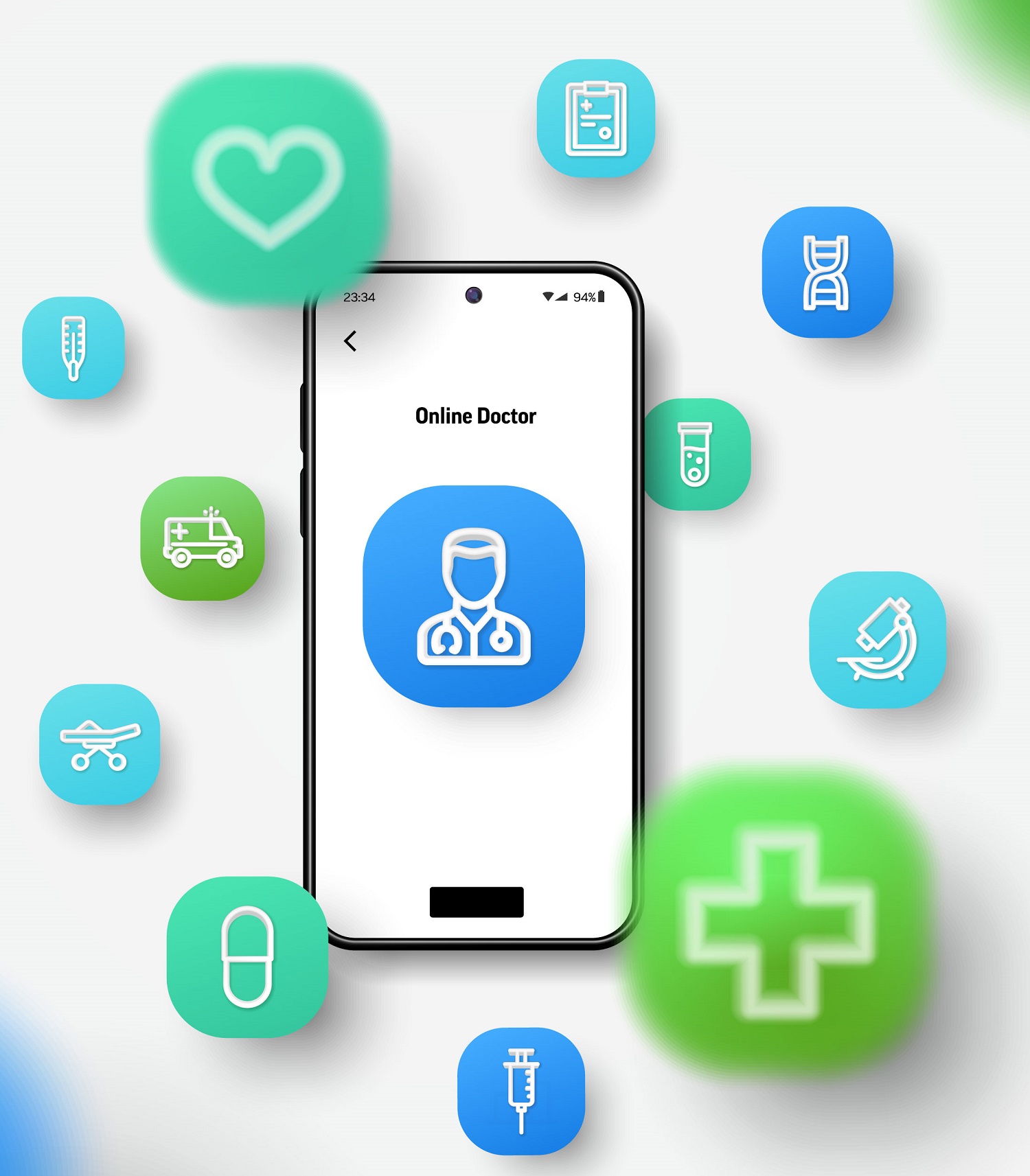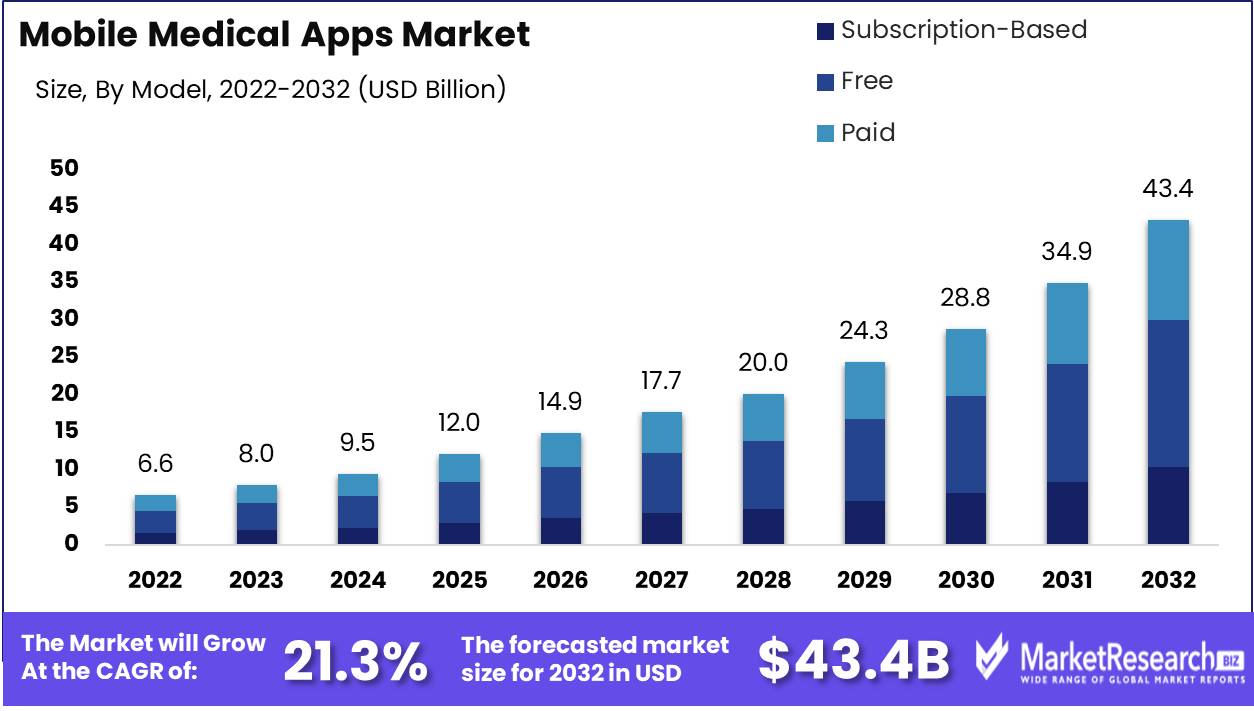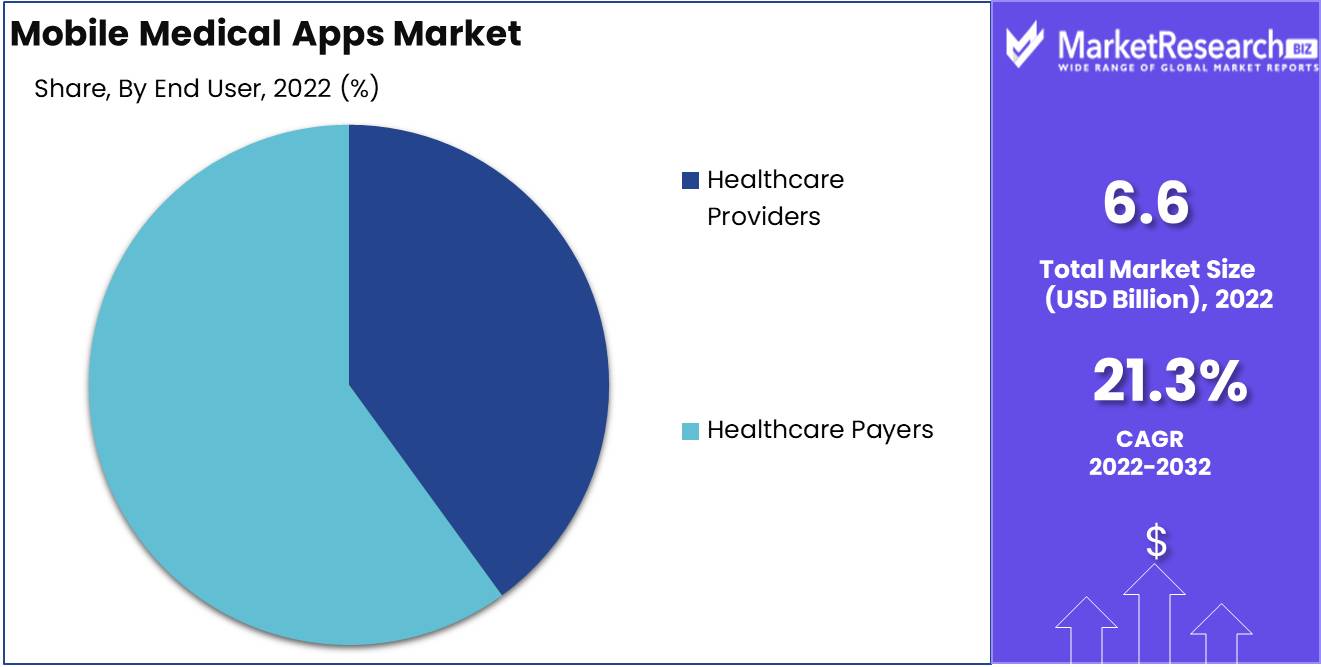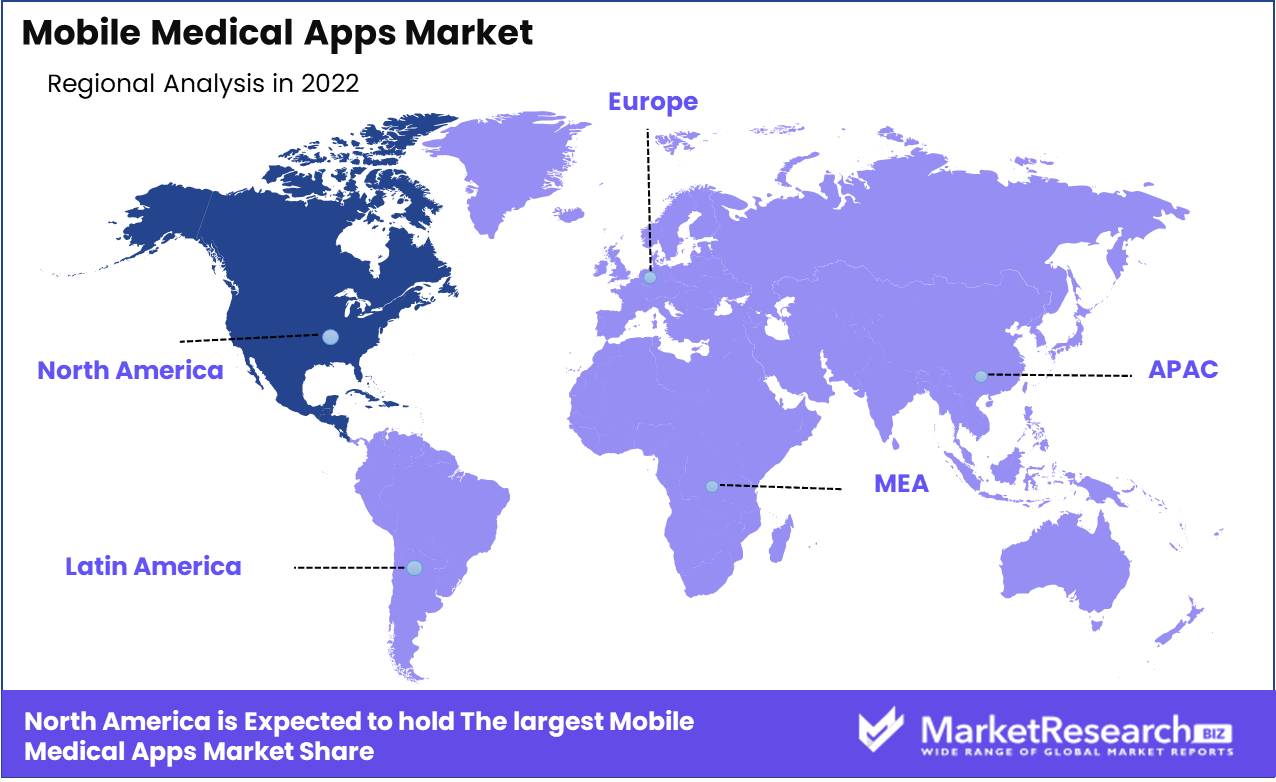
Mobile Medical Apps Market By Therapeutic Area (Cardiovascular, Diabetes, Other), By Model (Subscription-Based, Free), By Application (Diagnostics, Remote Monitoring & Consultation, and Other), By End User (Healthcare Providers, Healthcare Payers), By Region And Companies - Industry Segment Outlook, Market Assessment, Competition Scenario, Trends, And Forecast 2023-2032
-
39620
-
July 2023
-
173
-
-
This report was compiled by Correspondence Linkedin | Detailed Market research Methodology Our methodology involves a mix of primary research, including interviews with leading mental health experts, and secondary research from reputable medical journals and databases. View Detailed Methodology Page
-
Quick Navigation
Report Overview
Mobile Medical Apps Market size is expected to be worth around USD 43.4 Bn by 2032 from USD 6.6 Bn in 2022, growing at a CAGR of 21.3% during the forecast period from 2023 to 2032.
The mobile medical apps market is growing, and there are many opportunities for growth. Within this context, it is possible to recognize the overarching significance and myriad benefits that these apps provide to the healthcare industry. The sector has undergone a profound transformation, heralding an era of accessibility, efficiency, and cost-effectiveness. By providing patients with unprecedented access to personalized healthcare information, these apps empower users to take charge of their health.

The integration of artificial intelligence (AI) and machine learning (ML) technologies has been one of the most notable developments in the mobile medical apps industry over the past few years. By leveraging these cutting-edge innovations, apps can now provide personalized healthcare recommendations based on an individual's health data and patterns. In addition, the integration of wearable devices with mobile medical apps has accelerated the emergence of real-time health monitoring, thereby fostering the growth of both preventative and reactive healthcare measures.
The market for mobile medical apps is exploding, and it's easy to see why. Numerous titans from the realms of technology, pharmaceuticals, and entrepreneurial endeavors have recognized the transformative potential of this domain, thereby investing substantial resources in its fertile soil. As a result, a union between mobile medical apps and medical devices, health insurance plans, and telemedicine services has occurred, amplifying the market's influence and expanding its reach beyond the confines of convention.
Indeed, the growth and applications of the mobile medical apps market are pervasive, permeating every aspect of the healthcare industry. The following are some of the most common questions we receive about our services. Individuals, healthcare providers, researchers, and even governments now employ them as indispensable instruments to overcome healthcare challenges, reduce costs, and propel medical research to uncharted heights.
Multiple industries have set their sights on the mobile medical apps market, attesting to its limitless growth potential and profound impact. Within the hallowed corridors of the healthcare industry, practitioners seek to optimize patient care, increase operational efficiency, and promote innovation. Nonetheless, the allure of this market extends beyond healthcare, luring technology companies, pharmaceutical tycoons, insurance providers, and research institutions to participate in its transformative force, thereby effectively reshaping the landscape of healthcare services.
Driving factors
Smartphone Transforms Healthcare
Smartphone adoption has surged to unprecedented levels around the world. Smartphones have replaced other devices as the primary means of accessing information and services as they have become a crucial part of our daily existence. The healthcare industry has capitalized on this trend by leveraging the capabilities of smartphones to improve patient care and doctor-patient interactions. Mobile medical apps allow patients to conveniently access healthcare services, monitor their health vitals, schedule appointments, and receive personalized healthcare recommendations.
Patient Care Is Transformed by Telemedicine
Telemedicine, a subset of telehealth, is revolutionizing healthcare by allowing remote patient consultations and diagnosis via mobile apps. Without an in-person visit, telemedicine apps connect patients with healthcare professionals, allowing them to receive medical advice and even treatment. This has proven especially advantageous for patients with limited mobility or who reside in remote areas. These apps enable patients to monitor their health parameters, such as blood glucose levels and blood pressure, and exchange the data in real-time with their healthcare providers.
App-Based Personalized Healthcare
Advances in healthcare technology have enabled providers to offer personalized healthcare via mobile apps. These apps utilize algorithms and patient data to generate individualized recommendations and treatment plans. In order to generate precise insights and recommendations, personalized healthcare apps can analyze patient health records, lifestyle habits, genetic information, and other pertinent data. Rapidly increasing demand for personalized healthcare solutions is propelling the growth of the mobile medical apps market.
Innovation in Technology Drives the Medical Applications Market
Innovation in technology is one of the primary growth drivers for the mobile medical apps market. From artificial intelligence and machine learning to virtual reality and wearables, the healthcare industry is experiencing a proliferation of innovative technologies that are revolutionizing patient care. The use of mobile devices to deliver healthcare is a growing trend. Apps that incorporate virtual reality technology, for instance, can provide immersive experiences for both patients and healthcare professionals, thereby augmenting diagnosis, treatment, and surgical planning.
Restraining Factors
Data Security and Privacy Growing Fear
In a digital landscape that is constantly evolving, the mobile medical apps market is acquiring significant traction in providing innovative healthcare solutions. These applications are revolutionizing the interaction between patients and healthcare professionals by facilitating remote monitoring, diagnosis, and treatment. Despite the enormous potential and benefits offered by mobile medical apps, the market's growth and widespread adoption continue to be hampered by a number of restraining factors.
The Clarity in Regulatory Matters Is Crucial for Market Growth
The use of a mobile medical app is a common practice, but it is also important to consider the potential for privacy and security. As these applications acquire and process sensitive patient data, it becomes imperative to safeguard patient confidentiality and prevent unauthorized access. Fear of data breaches and cyberattacks hangs over the market, discouraging patients and healthcare providers from embracing mobile medical apps fully.
Operating System Compatibility Challenges Dilemma
The absence of regulatory clarity is another significant factor restraining the mobile medical apps market. Given the rapid advancement of technology and the proliferation of new apps, it is difficult for regulatory bodies to keep up with the shifting landscape. In the absence of distinct guidelines and regulations, developers frequently experience confusion, impeding innovation and market expansion. By resolving these regulatory ambiguities and establishing comprehensive guidelines, confidence can be instilled in both developers and consumers, thereby advancing the market.
App Quality Variability Ensuring Reliability
The limited reimbursement options pose a significant barrier to the widespread adoption of mobile medical apps, despite their enormous potential for streamlining healthcare delivery. Traditional methods of care, such as in-person consultations and treatments, are reimbursed by healthcare systems, whereas the mobile medical apps market frequently falls outside the existing reimbursement framework. To encourage the integration of these apps into healthcare systems, it is necessary to establish appropriate reimbursement mechanisms that enable healthcare providers to be adequately compensated for using app-based services.
Certifying Reliable Applications Builds Credibility
The market for mobile medical apps is flooded with numerous products of varying quality and effectiveness. This variation in app quality raises concerns among healthcare professionals and patients, as they require assurance that the apps they use are accurate, dependable, and evidence-based. The safety, accuracy, and effectiveness of mobile medical apps could be certified, which would increase user confidence. Establishing explicit quality standards and a certification procedure would encourage developers to create high-quality apps, thereby creating a more robust and credible market.
Therapeutic Area Analysis
In recent years, the diabetes segment has dominated the mobile medical apps market. Due to global diabetes prevalence and increased self-management tool demand, this segment has grown significantly. Diabetes management applications provide real-time monitoring and individualized support.
Emerging economies' economic growth has driven diabetes segment adoption. Due to lifestyle changes and aging populations, diabetes rates have risen rapidly in these economies. Thus, governments and healthcare professionals in these countries have realized the need for novel diabetes management options. Mobile medical apps are a cost-effective way to reach more people with vital healthcare services.
The diabetes segment dominates the mobile medical apps market due to consumer trends and behavior. Diabetes patients are becoming more proactive and demanding convenient and individualized care. They can track food, exercise, and medication with mobile medical apps. These apps are popular with diabetics due to their convenience and flexibility, fueling segment growth.
Model Analysis
The free segment dominates the mobile medical apps market. Because they're free, free apps are popular. These applications offer basic health and well-being monitoring. Free apps are a good alternative to expensive healthcare solutions for many people, especially those on a budget.
As in the preceding section, economic development in emerging economies has driven the free segment of the mobile medical apps market. Large populations in these economies often lack healthcare. Free mobile medical apps can fill this gap and provide basic healthcare to more people. These apps are affordable for low-income users.
Consumer trends and behavior also drive the free segment of the mobile medical apps market. Many people prefer free apps before buying them. They can test the app's features and usability before buying a premium version. The large range of free therapeutic applications encourages people to try them and use their fundamental capabilities.
Application Analysis
The mobile medical apps market is dominated by the health and wellness industry, with the majority of the market's share coming from the United States. These applications track fitness, nutrition, stress, and sleep. Health and wellness management applications are popular among people trying to live a healthy lifestyle due to increased awareness of well-being.
Emerging economies have driven health and wellness management app use. As these economies mature, people are emphasizing their health and actively seeking methods to sustain a healthy lifestyle. Health and wellness management applications give customers individualized advice to make informed health decisions. These apps appeal to many people due to their price and ease.
Consumer trends and behavior help the health and wellness management segment dominate the mobile medical apps market. People are seeking strategies to control their health and prevent sickness as preventative healthcare becomes more popular. Health and wellness management applications help them improve their health by tracking and providing customized insights. Health and wellness management apps for all needs and preferences boost their appeal.
End User Analysis
The healthcare payers segment dominates the mobile medical apps market, serving insurance providers and other stakeholders. These apps help healthcare payers improve efficiency, patient experience, and operations. Healthcare payers may automate procedures like claims processing and policy management with mobile medical apps, saving money and improving service.
The healthcare payers segment has adopted mobile medical apps due to emerging economies' economic growth. Healthcare is changing along with these economies. Digital solutions are becoming increasingly important to healthcare payers in managing operations and meeting customer requests. Mobile medical apps make it easy for healthcare payers to improve their services and stay competitive.
Consumer trends and behavior help the healthcare payers segment dominate the mobile medical apps market. Patients want openness, ease, and personalization from healthcare providers. Mobile medical apps with user-friendly interfaces, real-time health information, and smooth communication channels help healthcare payers achieve these expectations.

Key Market Segments
By Therapeutic Area
- Cardiovascular
- Diabetes
- Respiratory
- Neurology
- Other Therapeutic Areas
By Model
- Subscription-Based
- Free
- Paid
By Application
- Diagnostics
- Remote Monitoring & Consultation
- Health & Wellness Management
- Chronic Disease Management
- Nutrition Apps
- Other Applications
By End User
- Healthcare Providers
- Healthcare Payers
Growth Opportunity
RPM Transforms Healthcare
The mobile medical apps market has transformed chronic disease management via remote patient monitoring (RPM). These apps empower patients to actively participate in their healthcare by monitoring their vital signs and health metrics at home. RPM gives healthcare practitioners real-time patient data for quicker interventions and enhanced decision-making.
AI-Assisted Care
The mobile medical apps market has the potential to improve chronic illness management by leveraging RPM. These apps use AI and machine learning algorithms to examine massive patient data and detect trends, abnormalities, and patterns that humans may miss. The ability to use your imagination to solve problems is a powerful tool, and it may be used to your advantage. RPM, AI, and machine learning have the potential to revolutionize personalized healthcare and improve patient outcomes.
Mobile Health Apps
Mobile medical apps have penetrated developed countries, but emerging markets have huge untapped potential. Mobile technology is booming in countries with poor healthcare infrastructure, providing a unique chance to close the gap. Mobile medical apps market can deliver important healthcare services to marginalized people, including remote consultations, diagnostics, and market information.
AI Breaking Boundaries
The integration of AI and machine learning in mobile medical apps can assist overcome language barriers and cultural variations by offering real-time translation and culturally relevant advice. This integration helps patients and healthcare practitioners communicate, assuring accurate diagnoses and personalized treatment regimens regardless of location. The mobile medical apps market can transform global healthcare by leveraging emerging markets' potential.
Latest Trends
Mental Health App Demand Rising
Global awareness of mental health issues is driving demand for creative treatments. Mental health apps provide users with a variety of tools and approaches to manage stress, anxiety, depression, and other mental health disorders. For customers looking for efficient self-help options, these apps offer adjustable features such as therapy sessions, meditation exercises, mood trackers, and personalized recommendations.
Medical App Usability Improvement
In order to succeed, you must have a good reason to do so. A pleasant user experience depends on seamless navigation, intuitive interfaces, and visually appealing designs. The use of artificial intelligence (AI) and machine learning (MLM) to create a more personalized experience for users is a growing trend. The following is a list of all the ways in which we may help you.
Mobile Medical Apps Promote Interoperability
Health data integration across healthcare systems and devices has long been a challenge. Interoperability is being promoted in the mobile medical apps market to solve this problem. Mobile health apps improve care coordination, patient empowerment, and overall healthcare efficiency by integrating EHRs and permitting safe data transmission.
VR/AR Change Healthcare Apps
The use of virtual reality (VR) and augmented reality (AR) in healthcare is becoming more and more common. The ability to use the Internet of Things (IoT) to communicate with others is a major benefit of this technology. AR helps in vein localization and guided surgeries by overlaying digital information on real-world scenes. In order to improve patient outcomes, mobile medical apps must be used.
Regional Analysis
The mobile medical apps market is continuously changing healthcare technology. These apps give healthcare professionals and patients new features and information, making healthcare more accessible and efficient. North America dominates the mobile medical apps market.
Mobile medical apps have grown rapidly in North America. Personal health monitoring, remote patient monitoring, medication management, and illness management are all possible with the use of such apps. The prevalence of chronic diseases, as well as the need for a more comprehensive approach, are all factors that contribute to the success of the industry.
North America's excellent healthcare infrastructure helps it dominate the mobile medical apps market. The US has a solid healthcare system with modern medical facilities and a focus on technology. This fosters the development and adoption of mobile medical apps.
Several major technology companies in North America have helped expand the mobile medical apps market. These companies have the skills and resources to create breakthrough apps for healthcare professionals and patients. The growth of mobile medical apps is a direct result of the region's advantageous tax climate, which has led to the development of the industry.

Key Regions and Countries
North America
- US
- Canada
- Mexico
Western Europe
- Germany
- France
- The UK
- Spain
- Italy
- Portugal
- Ireland
- Austria
- Switzerland
- Benelux
- Nordic
- Rest of Western Europe
Eastern Europe
- Russia
- Poland
- The Czech Republic
- Greece
- Rest of Eastern Europe
APAC
- China
- Japan
- South Korea
- India
- Australia & New Zealand
- Indonesia
- Malaysia
- Philippines
- Singapore
- Thailand
- Vietnam
- Rest of APAC
Latin America
- Brazil
- Colombia
- Chile
- Argentina
- Costa Rica
- Rest of Latin America
Middle East & Africa
- Algeria
- Egypt
- Israel
- Kuwait
- Nigeria
- Saudi Arabia
- South Africa
- Turkey
- United Arab Emirates
- Rest of MEA
Key Players Analysis
These innovators are driving mobile medical app growth. Apple, Medtronic, Samsung, Philips, iHealth Labs, and AT&T Intellectual Property have shown their commitment to patient care, remote healthcare, and active patient participation.
Apple Inc. leads the mobile medical apps market with its robust ecosystem and seamless hardware-software integration. They created the HealthKit framework and app to let users manage and monitor their health data. Health Records lets users securely save and exchange medical records with healthcare providers.
Medtronic, a medical technology giant, has advanced mobile medical apps. The best way to learn about a company's health is to visit its website. Medtronic's innovative solutions help patients manage diabetes and heart disease.
Samsung, known for its electronics, has made significant inroads into the mobile medical apps market. Their smartwatches and fitness trackers effortlessly incorporate health monitoring features. Samsung Health, their flagship app, provides users with complete health and fitness statistics to promote an active and healthy lifestyle.
Koninklijke The Philips Group, Inc. is a global leader in healthcare innovation. The company offers a wide range of products and services, including vital sign monitoring and telehealth. Philips uses mobile technology for remote consultations, imaging, and patient management. Their commitment to scalable and effective solutions has helped bridge the gap between patients and healthcare professionals.
The iHealth Labs team's mission is to help people live healthier lives by providing them with the tools they need to succeed. Their easy mobile app syncs with their wireless blood pressure monitors, glucose meters, and activity trackers. Through precise and real-time data tracking, patients can actively participate in their health, supporting early intervention and better healthcare outcomes.
Telecom leader AT&T Intellectual Property transforms the mobile medical apps market. Their reliable network architecture and connection solutions enable remote patient monitoring and connected care. AT&T helps chronically ill patients receive home-based care by partnering with healthcare professionals and developing remote monitoring equipment.
Top Key Players in the Mobile Medical Apps Market
- Apple Inc (U.S.)
- Medtronic (Ireland)
- SAMSUNG (South Korea)
- Koninklijke Philips N.V. (Netherlands)
- iHealth Labs Inc (U.S.)
- AT&T Intellectual Property. (U.S.)
- Allscripts Healthcare, LLC (U.S.)
- Qualcomm Technologies, Inc. (U.S.)
- Cerner Corporation. (U.S.)
- Evolent Health, Inc. (U.S.)
- Oscar Insurance (U.S.)
- Zest Health (U.S.)
- athenahealth, Inc. (U.S.)
- OMRON Corporation (Japan)
- Nokia (Finland)
- Cisco Systems, Inc. (U.S.)
- AIRSTRIP TECHNOLOGIES, INC. (U.S.)
- BioTelemetry, Inc. (U.S.)
- AliveCor, Inc. (U.S.)
Recent Development
- In 2023, Babylon Health, a London-based digital health firm, shocked the healthcare industry with the launch of its much-anticipated Babylon app.
- in 2022, With its innovative KardiaMobile 6L ECG app, AliveCor, a pioneer in the digital health industry, lifted the bar again.
- In 2021, San Francisco-based healthcare company Nurx launched its breakthrough Nurx app.
- In 2020, The company's flagship, Teladoc, is a leader in the field of virtual health care.
- In 2019, The launch of the company's mobile app, which is a part of the healthcare industry, was announced by the company in a press release.
Report Scope
Report Features Description Market Value (2022) USD 6.6 Bn Forecast Revenue (2032) USD 43.4 Bn CAGR (2023-2032) 21.3% Base Year for Estimation 2022 Historic Period 2016-2022 Forecast Period 2023-2032 Report Coverage Revenue Forecast, Market Dynamics, COVID-19 Impact, Competitive Landscape, Recent Developments Segments Covered By Therapeutic Area (Cardiovascular, Diabetes, Respiratory, Neurology, Other Therapeutic Areas), By Model (Subscription-Based, Free, Paid), By Application (Diagnostics, Remote Monitoring & Consultation, Health & Wellness Management, Chronic Disease Management, Nutrition Apps, Other Applications), By End User (Healthcare Providers, Healthcare Payers) Regional Analysis North America – The US, Canada, & Mexico; Western Europe – Germany, France, The UK, Spain, Italy, Portugal, Ireland, Austria, Switzerland, Benelux, Nordic, & Rest of Western Europe; Eastern Europe – Russia, Poland, The Czech Republic, Greece, & Rest of Eastern Europe; APAC – China, Japan, South Korea, India, Australia & New Zealand, Indonesia, Malaysia, Philippines, Singapore, Thailand, Vietnam, & Rest of APAC; Latin America – Brazil, Colombia, Chile, Argentina, Costa Rica, & Rest of Latin America; Middle East & Africa – Algeria, Egypt, Israel, Kuwait, Nigeria, Saudi Arabia, South Africa, Turkey, United Arab Emirates, & Rest of MEA Competitive Landscape Apple Inc (U.S.), Medtronic (Ireland), SAMSUNG (South Korea), Koninklijke Philips N.V. (Netherlands), iHealth Labs Inc (U.S.), AT&T Intellectual Property. (U.S.), Allscripts Healthcare, LLC (U.S.), Qualcomm Technologies, Inc. (U.S.), Cerner Corporation. (U.S.), Evolent Health, Inc. (U.S.), Oscar Insurance (U.S.), Zest Health (U.S.), athenahealth, Inc. (U.S.), OMRON Corporation (Japan), Nokia (Finland), Cisco Systems, Inc. (U.S.), AIRSTRIP TECHNOLOGIES, INC. (U.S.), BioTelemetry, Inc. (U.S.), AliveCor, Inc. (U.S.) Customization Scope Customization for segments, region/country-level will be provided. Moreover, additional customization can be done based on the requirements. Purchase Options We have three licenses to opt for: Single User License, Multi-User License (Up to 5 Users), Corporate Use License (Unlimited User and Printable PDF) -
-
- Apple Inc (U.S.)
- Medtronic (Ireland)
- SAMSUNG (South Korea)
- Koninklijke Philips N.V. (Netherlands)
- iHealth Labs Inc (U.S.)
- AT&T Intellectual Property. (U.S.)
- Allscripts Healthcare, LLC (U.S.)
- Qualcomm Technologies, Inc. (U.S.)
- Cerner Corporation. (U.S.)
- Evolent Health, Inc. (U.S.)
- Oscar Insurance (U.S.)
- Zest Health (U.S.)
- athenahealth, Inc. (U.S.)
- OMRON Corporation (Japan)
- Nokia (Finland)
- Cisco Systems, Inc. (U.S.)
- AIRSTRIP TECHNOLOGIES, INC. (U.S.)
- BioTelemetry, Inc. (U.S.)
- AliveCor, Inc. (U.S.)




